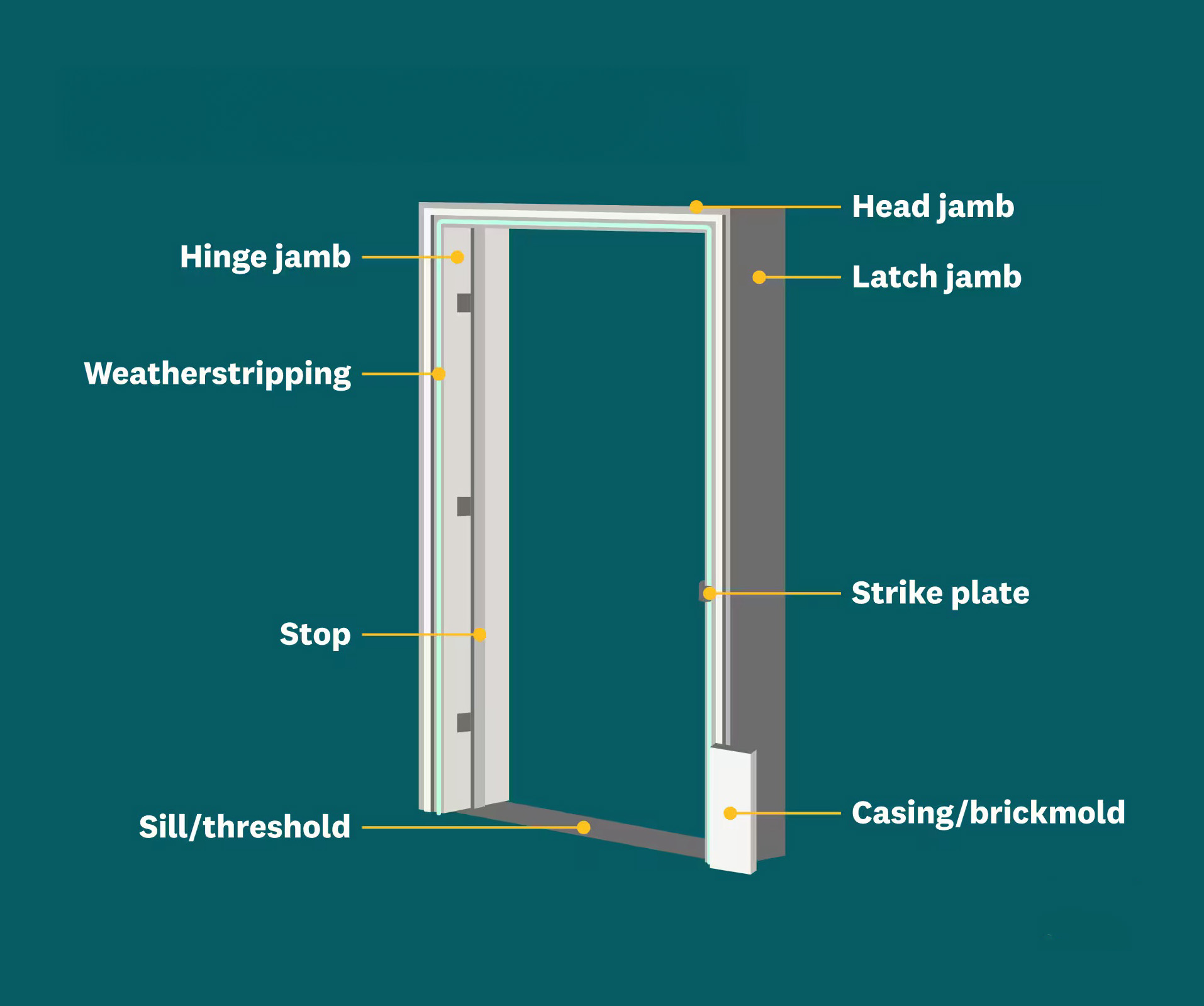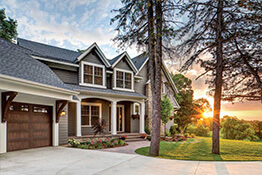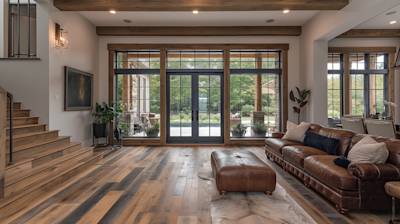A door isn't just an entrance into a building or a room; it is a vital aspect of the architecture. Attached to rooms' structures, they offer privacy and security while contributing to the overall aesthetics of the space. One component that we often overlook in the door assembly is the door jamb. The humble yet important door jamb deserves a comprehensive examination.
What is a Door Jamb?
The term door jamb refers to the vertical portions of the door frame, where the hinges are mounted, and the latch engages. It's an essential part of a door frame that houses the door and imparts it strength and durability. Door jambs are available in multiple materials including wood, metal, and aluminum among others. It is designed to withstand force and prevent the door from slamming, thereby protecting the wall and keeping the structure intact.
Parts of a Door Jamb

Door jamb structure is composed of several parts, each serving a particular function:
- Sill: This is the bottom piece of the door frame, often designed to withstand heavier weight.
- Head: This is the top part of the door jamb parallel to the sill.
- Side Jambs: These vertical members flank the sides of the door, typically attached to the wall studs.
Types of Door Jambs
Door jambs vary in types and are often chosen based on the type of door, the exterior texture, and the desired level of security. The two primary types are:
- Flat Jambs: Mainly used in homes with plaster walls, these are flat surfaces that require little adjustment.
- Rabbeted Jambs: Commonly found in modern homes, these have a specific groove to house the door.
Installation of a Door Jamb
The process of installing a door jamb, while precise, can be accomplished with some knowledge and tools. Here's how it's typically done:
- The first step involves measuring the door size, followed by the jamb size.
- Next, the door stop is cut and nailed into the jamb.
- After attaching the hinges, the jamb is then installed onto the doorway.
- Finally, the door is carefully aligned with the jamb and secured.
Purchasing a Door Jamb
When you're in the market for a door jamb, several factors should be considered:
- Material: Make sure to choose a material that is sturdy and aligns with your door type.
- Sizing: Correct size is extremely critical for a good fit and easy installation.
- Quality: Look at the quality of the jamb for an aesthetic look and lasting durability.
Maintenance of Door Jambs
With regular use, it's not uncommon for a door jamb to sustain damage over time. In many cases, you can perform some simple maintenance techniques to keep the door jamb in good condition. It might need cleaning, painting, or both, depending on the material and the extent of the damage. In more severe cases, the jamb may need to be repaired or replaced.
Replacement of Door Jambs
When damage is too extensive, you might need to get the door jamb replaced. Replacing a door jamb requires careful measurements, removal of the old jamb, and clean installation of the new one.
Always keep in mind, the door jamb is a cornerstone of your door's functionality and aesthetic appeal, and thus deserves the same attention as the rest of your home. By understanding its purpose, structuring, and maintenance, you can ensure it does its job effectively and contributes positively to your home's appearance.
Frequently Asked Questions About Door Jambs
Here are some of the most frequently asked questions about door jambs that you might find useful:
What are the components in a door jamb?
A door jamb consists of two vertical sides and one top side. These are also known as the header jamb and the side jambs. The header jamb is horizontal and it is placed on the top side, while the side jambs are vertical and are placed on both sides of the door frame.
Why are door jambs essential?
Door jambs are crucial for several reasons. They provide support to the doorway structure and the doorway itself. They also offer a place for door hardware such as hinges and latches to be installed. Lastly, they help in creating a seal when the door is shut, promoting energy efficiency and blocking out noise and harsh weather conditions.
How can I replace a door jamb?
To replace a door jamb, you need to first remove the existing door jamb, measure and cut the new door jamb, fix it into place, sand it smooth, then paint or stain it to match the door.
How to repair a damaged door jamb?
You can repair a damaged door jamb by cutting out the damaged area and replacing it with a similar piece of wood. Once repaired, it should be sanded to make it smooth and then painted to match the rest of the door frame.
What is a split jamb door?
A split jamb door is a kind of interior that comes in two parts – one part of the jamb is fixed on the door frame and the other one is fixed on the wall. This makes the installation process easier as it can be adjusted to accommodate different wall thicknesses.
What’s the difference between a door jamb and a door frame?
A door jamb is a part of the door frame. To be specific, door jambs are the sides of the door frame, whereas the door frame refers to the entire structure surrounding the door including the jamb, head, sill, and threshold.
How to measure a door jamb?
To measure a door jamb, you have to measure the width from one side to the other, and the height from the top to the base of the floor. It is vital to note that you have to take measurements from the widest and highest points.
What is a jamb extension?
A jamb extension is an extra piece of material that extends the depth of the exterior door frame. It is used when the wall thickness is greater than the jamb depth of a pre-hung door. This ensures that the door can properly fit despite a thicker wall.
What is a door stop on a jamb?
A door stop on a jamb refers to the strip of either wood or metal that is fixed onto the door jamb to prevent the door from swinging past the framed opening or into the wall.
What kind of wood is best for a door jamb?
Wooden door jambs can be constructed from a variety of woods, depending on the type of door, location, and weather conditions. Hardwoods like oak, mahogany, or cherry are often used for exterior door jambs due to their durability, while softwoods like pine, fir, or cedar are commonly used for interior door jambs.
We hope these answers help you understand more about door jambs. Please reach out if you have any other questions.
Pros & Cons of Door Jambs
Pros of Door Jambs
Structural Integrity & Support
- Robust Construction: Door jambs are typically made of strong, durable materials like wood or metal. This provides crucial support and structural integrity to the door and the surrounding wall.
- Rigidity: A solid door jamb helps to ensure that the door remains in alignment, preventing it from warping or sagging over time.
Secure Installation
- Secure Fitting: Door jambs act as the anchoring point for doors. They help secure the door in place, and ensure it opens and closes smoothly.
- Lock and Latch Support: The door jamb is an integral part of the locking mechanism, providing a place for the latch and deadbolt to secure.
Energy Efficiency
- Insulation: Door jambs provide a seal between the door and the frame. This helps to reduce drafts and heat loss, contributing to improved energy efficiency in the home.
Decorative Appeal
- Style and Elegance: Beyond their functional role, door jambs also enhance the aesthetic appeal of a door. They are often intricately crafted or feature beautiful woodwork, adding to the overall appearance of a room.
Cons of Door Jambs
Wear and Tear
- Damage from Use: Door jambs, particular those in heavy duty areas, are susceptible to wear and tear. Frequent opening and closing of the door may cause the jamb to weaken over time.
- Susceptible to Moisture: Especially for wooden door jambs, exposure to moisture can lead to rotting or warping, requiring replacement.
Installation and Replacement Difficulties
- Installation Challenges: Setting up a door jamb can be quite challenging, particularly for those lacking handyman skills. It requires precise measurements and an understanding of the door assembly process.
- Replacement Struggles: If a door jamb becomes damaged, replacing it can be tricky. In most cases, the entire door and frame may need to be removed to efficiently replace the door jamb.
Summary
All in all, a door jamb plays a crucial role when it comes to the functionality and effectiveness of a door. It supports the door frame, ensures the door opens and shuts correctly, and also provides a certain level of home security. By maintaining the door jamb in good condition, the longevity and durability of the whole door setup increase.
Practically speaking, the door jamb does serve a prominent role in home insulation. A well-installed and properly-sealed door jamb prevents warm or cool air from leaking out, thus improving energy efficiency in our homes. So next time you save on energy bills, remember it's partially thanks to your door jamb.
And finally, we must not overlook the design aspect of a door jamb. With the variety of styles, materials, and finishes available, they can be an interesting detail that contributes to the overall aesthetics of our home or office. So don't underestimate the importance and value of a simple thing like the door jamb, because it's much more than it appears.
About US Quality Construction of Columbus
Welcome to US Quality Construction of Columbus, based in the illustrious city of Columbus, OH! We are a dedicated team of seasoned professionals committed to excellence, integrity, and customer satisfaction. With years of construction experience under our belts, we're focused on providing top-notch quality and unparalleled workmanship to our clients. Whether it is residential or commercial, every project we undertake is subject to the highest standards.
Tags: door jamb, maintenance, repair,









